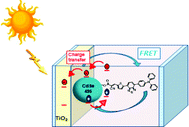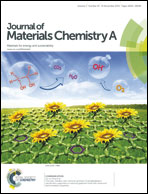Enhanced photovoltaic performance with co-sensitization of quantum dots and an organic dye in dye-sensitized solar cells†
Abstract
CdSe quantum dots of two different sizes exhibiting a maximum emission at 495 nm (CdSe495) and 545 nm (CdSe545) were combined with di-tetrabutylammonium cis-bis(isothiocyanato)bis(2,2-bipyridyl-4,4-dicarboxylato)ruthenium(II) (N719) or 2-cyano-3-{5-[7-(4-diphenylamino-phenyl)benzo[1,2,5]thiadiazol-4-yl]-thiophen-2-yl}-acrylic acid (TBTCA) resulting in four novel hybrid organic–inorganic sensitizers, which were used in the fabrication of dye-sensitized solar cells. The results showed that with N719, both the CdSe dots decreased the power conversion efficiencies when compared to a standard device consisting only of N719 as the sensitizer. With the organic dye TBTCA, CdSe545 showed no significant effect, while CdSe495 interacted favorably, leading to a 25% increase in power conversion efficiency compared to a device sensitized solely by TBTCA. Studies on excited-state lifetimes of N719 in the presence of CdSe did not distinguish between energy and/or charge transfer mechanisms. On the other hand, time correlated single photon counting experiments on the photoelectrodes suggest that the advantages due to the CdSe495–TBTCA combination could be ascribed to FRET from quantum dots to the organic dye and to a further contribution, as suggested by IPCE spectra, consisting of electron transfer via cascade from the LUMO level of TBTCA to CdSe495 to TiO2, which produces a higher flux of electrons in the external circuit.


 Please wait while we load your content...
Please wait while we load your content...